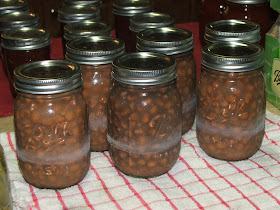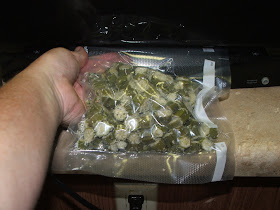I got some beautiful red plums at the farmers market... what to do with them?
I love fruit and I love to make jams, jellies, and preserves, but in all honesty, we don't eat that much of it... we tend to have more than we need most of the time. Now if you're talking my brother's peach preserves, that's a different story... I can eat that stuff with a spoon, no bread needed! But as a rule, jams and jellies last awhile at our house... I give a lot away as gifts.
So... imagine my delight when I happened upon a recipe for plum sauce... using fruit... my beautiful plums... and it's not jam! Yay!
This sweet and spicy sauce is wonderful with Asian style foods, chicken... and is wonderful with pork dishes... I've cooked pork tenderloin and chops... slow cooking in the oven in my covered terra cotta cooker (that I got at a yard sale for $3, yay me!) and it's fabulous! I've used it as a dipping sauce for everything from prosciutto wrapped figs to chicken nuggets.
Here's how I made this delicious, versatile sauce...
In a large, stainless steel saucepan I combined...
2 cups lightly packed brown sugar
1 cup granulated sugar
1 cup apple cider vinegar
3/4 cup chopped onion (I used red onions because I had them on hand, use whatever you like)
2 Tbsp. finely chopped seeded green chili pepper (I made two batches... in one batch I used jalapenos, in another, the small chili peppers... they're both great, use peppers with the "hotness" you like)
2 Tbsp. mustard seeds
1 Tbsp. salt (I used canning/pickling salt )
)
2 cloves garlic, finely chopped
1 Tbsp. gingerroot, finely chopped (I had some crystallized ginger on hand, used it with great results)
on hand, used it with great results)
I brought the mixture to a boil over high heat, stirring constantly.
I added 10 cups chopped, pitted plums...
And returned to a boil. I then reduced the heat and boiled gently, stirring occasionally, until thick and syrupy... took between and hour and a half and two hours.
While my sauce was simmering and thickening, I prepared my half pint canning jars by heating them in a pan of boiling water. I simmered my lids and rings in boiling water and kept everything hot until my sauce was ready.
I ladled my hot sauce into the jars leaving about a half inch headspace, removed any air bubbles and adjusted headspace as needed. I wiped the rims and tightened the lids on to fingertip tightness.
I processed the jars in a boiling water bath... placing the jars in the canner ensuring they are completely covered with water... brought to a boil and processed for 20 minutes.
I removed the jars from the canner after processing using my jar lifter ... set them on a folded dish towel on the counter to cool and to listen for the PING of each successfully sealed jar.
... set them on a folded dish towel on the counter to cool and to listen for the PING of each successfully sealed jar.
*Remember... wear rubber gloves while seeding and chopping hot peppers or you WILL burn your hands! The best way to seed peppers is to trim off the stem end and then cut the pepper in half lengthwise. Scrape out the seeds and veins using a spoon.
Canning Granny©2011 All Rights Reserved

































